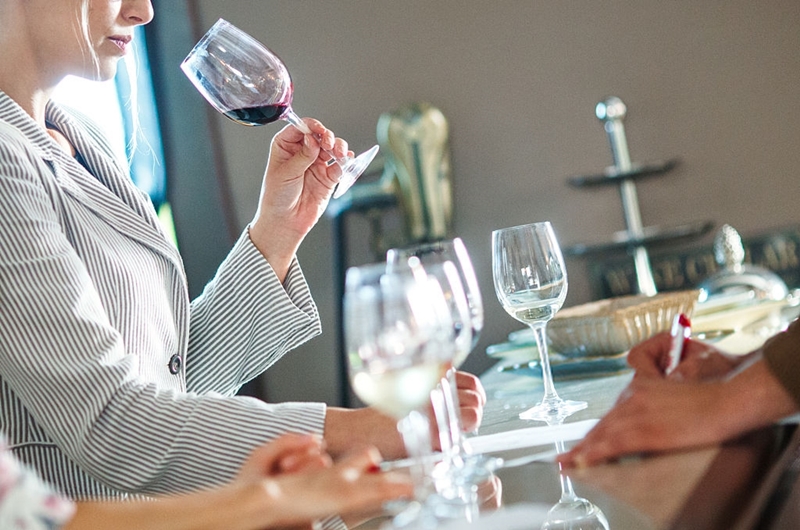A guide to different types of wine tastings
The world of wine tasting: techniques, types, and tips

Wine tasting is a refined practice that encompasses the act of examining, assessing, comparing, or identifying wines based on their color, aroma, taste, and tactile sensations in the mouth. It is an art form that requires technical knowledge and a certain level of preparation. In professional wine circles, anyone who tastes different wines for comparison, evaluation, assessment, and identification is referred to as a 'taster'. To be a professional taster, one needs technical knowledge and a certain level of preparation.
While in the English language, the word 'tasting' can also be used as a synonym for tasting or testing, which simply is the act of savoring or drinking small amounts of wine for pleasure or enjoyment, without the need for evaluation or comparison. Wine tasting, therefore, consists of three phases: the visual, the olfactory, and the gustatory, with the latter further divided into entry, evolution, and finish.
Wines are usually grouped into 'batches' for tasting, and those participating in the event can write testimonials about each wine they test or examine using the so-called 'tasting notes'. Wine tasting always involves comparison and evaluation, no matter how subjective it may be.
Different Types of Wine Tastings
Based on their purpose, the tasting procedure, and the harvest, there are different types of wine tastings. By nature, wine tastings can be of four distinct types:
Technical Tasting
Technical tasting is a professional activity carried out at the winery by the oenologist. It is conducted to determine and compare the characteristics of a wine against what is stipulated in its product or style sheet or to compare it against others, whether from the same winery, the competition, or from different vintages. This usually forms part of the 'analytics' of wines. Regular technical tastings of wines in deposits, barrels, or bottles are conducted, and parameters of winemaking, as well as a detailed organoleptic report, are included and recorded.
Commercial Tasting
This type of tasting is carried out by merchants, journalists, or enthusiasts. Commercial tastings influence purchasing and consumption decisions and also serve to develop wine guides and classifications, which will vary depending on the 'evaluation' systems used. The tasting can be carried out with the bottle revealed, as a blind tasting, or even as a double-blind tasting.
Pairing Tasting
In pairing tasting, wines are compared to determine the best accompaniments for specific dishes and foods.
Private Tasting
Private tasting is aimed at the valuation (or appraisal) of wine and, in a broader sense, all those criteria aimed at judging or determining the value or price of different wines, such as evaluating those exposed for bidding in 'auctions' or sales in advance, or simply for marketing. The classification process of wines, usually through tasting (either blind or with the bottle revealed), is carried out through elaborate tasting notes, awarding them a score that differentiates them according to their quality.
Blind Tasting
This is a common format in 'commercial tasting'. It can be carried out by professionals, journalists, or wine lovers in general, either in 'competitions' or simply for fun or to acquire knowledge. While in the tasting with the bottle revealed the taster can see the wine's brand, in the blind tasting, they cannot. The main objective is to ensure that the brand or the winery does not influence the 'evaluation' of the wine. Normally, the wines are grouped by homogeneous groups in batches (age, origin, style, grape variety, etc.) and the bottles are covered so that the brand is not visible on the bottle or the capsule. It is even better if the wines are poured into decanters of similar size to prevent any visual clue (silhouette of the bottle). In general, the chosen theme is known to the tasters, and the organizer knows the identity and order of the wines, although the latter does not participate. Its most extreme version is the 'double blind tasting'.
Double Blind Tasting
In double blind tasting, generally, neither the general theme nor the order of service of the wines is known, which is carried out by people unrelated to the tasters. It is very fashionable in some competitions, although it is somewhat chaotic on a professional level.
Horizontal Tasting
Horizontal tasting is a session where various wines are tasted, but from the same vintage. In this way, the different elaborations of the tasted wines and the quality of the grapes used are compared.
Vertical Tasting
Vertical tasting is one in which the same wine (brand or reference) but from different vintages is valued.
In conclusion, wine tasting is an intricate and multifaceted art that requires skill, knowledge, and a keen sense of observation. Whether you are a professional or an enthusiast, understanding the different types of tastings can enhance your appreciation and enjoyment of wine.
Founded in 2007, Vinetur® is a registered trademark of VGSC S.L. with a long history in the wine industry.
VGSC, S.L. with VAT number B70255591 is a spanish company legally registered in the Commercial Register of the city of Santiago de Compostela, with registration number: Bulletin 181, Reference 356049 in Volume 13, Page 107, Section 6, Sheet 45028, Entry 2.
Email: [email protected]
Headquarters and offices located in Vilagarcia de Arousa, Spain.